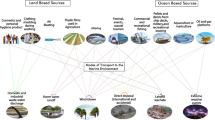Abstract
Extracts of sediment and water samples collected from Ulsan Bay, Korea, were screened for their ability to induce dioxin-like and estrogenic gene expression in vitro. Each sample was tested as raw extract (RE) and fractionated extract (FE). Based on the initial screening of RE, 23 of 31 sediment samples showed significant dioxin-like activity in H4IIE-luc bioassay, whereas most sediment samples did not elicit estrogenic response in MVLN bioassay. Most of the activities associated with FE samples revealed that mid-polar (F2) and most polar (F3) fractions were responsible for the significant reporter gene expression in H4IIE-luc bioassay. The results suggest that complex interactions may have depressed the activities of the known arylhydrocarbon receptor (AhR) agonists present in F1 samples. The F2 samples were the most active fraction. All F2 samples except one induced significant dioxin-like activity, and over half of the F2 samples induced significant estrogenic activity. Ten of the F2 samples produced magnitudes of response in H4IIE-luc bioassay similar to those induced by a 2,3,7,8-tetrachlorodibenzo-p-dioxin standard. Sediment associated with F2 samples was estimated to contain 24.9–826 pg TCDD-EQ/g DW. Based on a qualitative mass balance analysis, polycyclic aromatic hydrocarbons (PAHs) appeared to account for both the estrogenic and dioxin-like responses observed. Over half of the F3 samples were either cytotoxic or caused morphological changes in both H4IIE-luc and MVLN cells. Known concentrations of alkylphenols and bisphenol A were not great enough to account for both the estrogenic response and cytotoxicity observed for F3 samples. Despite the apparent toxic or stressful effects, most of F3 samples induced significant dioxin-like activity in vitro, adding to a growing body of evidence that suggests the presence of unidentified, relatively polar, AhR agonists in sediment from some areas.
Similar content being viewed by others
Author information
Authors and Affiliations
Additional information
Received: 11 June 2000/Accepted: 28 August 2000
Rights and permissions
About this article
Cite this article
Khim, J., Lee, K., Villeneuve, D. et al. In Vitro Bioassay Determination of Dioxin-Like and Estrogenic Activity in Sediment and Water from Ulsan Bay and Its Vicinity, Korea. Arch. Environ. Contam. Toxicol. 40, 151–160 (2001). https://doi.org/10.1007/s002440010158
Issue Date:
DOI: https://doi.org/10.1007/s002440010158




